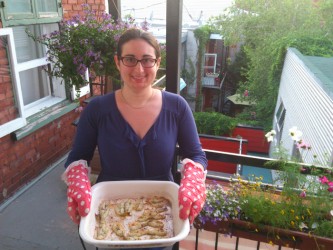Article Origin
Volume
Issue
Year
Marie-Anne Gagnon has discovered that Canada’s Centennial cookbooks provide more than recipes.
“By putting everything together, there is an overarching discourse of Aboriginal people being in the past and that modernity is emphasized to legitimize the claim of Euro-Canadians for being in Canada, and this is my interpretation,” said Gagnon.
Her major research paper for her Masters of Arts degree in Public History at Carleton University is focusing on Aboriginal foods as represented in the Canadian cookbooks in the 1960s.
“This appropriation of food kind of legitimizes the appropriation of land.”
Gagnon, who is of French-Canadian heritage, stumbled on the topic when she decided to learn more about Indigenous people. Having grown up in Canada’s education system, she realized she knew little about the country’s first people. As an undergrad, she began taking courses on Aboriginal issues. She started studying food and cultural diversity and that led her to examine Aboriginal foods and Canadian cookbooks.
When she looked at Centennial cookbooks that included Aboriginal recipes she found the situation “paradoxical.”
“Policies of assimilation, which were still going strong in the ‘60s, were trying to convince Aboriginal people that their traditional foods were no good, and I thought it was kind of ironic that they were celebrating Aboriginal food as … part of Canada’s food heritage,” said Gagnon.
Gagnon looked through dozens of late ’60s cookbooks, visiting the archives in Montreal as well as the University of Guelph, which has the largest cookbook collection in Canada.
Cookbooks that contained Aboriginal foods kept to the basics, in particular, maple syrup, corn, pumpkin, arctic char, and cranberries. Mentions of First Nations peoples were usually kept to “Indians” with no reference to specific First Nations. If the cookbook includes any information about Aboriginal people and their foods, it was usually in the first chapter and simplified.
Essentially, says Gagnon, the cookbooks relegate Aboriginal people to the past, claiming it is the settlers who tamed the wild and took the foods that Aboriginal people gathered to the next level.
“These recipes are hybrid, but they’re hybridized by Euro-Canadians,” she said. “We know that modern Aboriginal recipes are also hybridized and super creative and imaginative. But this isn’t recognized at all. What it says is that we Euro-Canadians have taken these foods and we’ve created all these recipes.”
Gagnon points out that she recently acquired a cookbook published in Kitigan Zibi and realized she had eaten the majority of those recipes growing up and that her father had unknowingly used the Anishinabeg term wàboz for rabbits.
Chef Rich Francis, who recently came into the spotlight as the first Aboriginal contestant on Top Chef Canada, where he finished third, says the 1960s’ cookbooks present grassroots recipes and looked more at the cooking methods of preparing the food.
“It was more survival staples. But today, we no longer have to hunt and gather for our food, so from a chef’s point of view it’s more what can we do with our commodities after we reclaim them,” he said.
While Aboriginal cuisine has found its way into numerous restaurants, the Indian taco still remains the food most people think about when Aboriginal food is mentioned, says Francis.
“It doesn’t even come close to expressing who we are as First Nations people. There’s nothing unique about it to us.”
Francis has his own way of combatting that image.
“I take all our traditional food, all of it, our traditional herbs and medicines and I use them in gastronomical terms for today’s industry. I try to keep my range as pre-contact as possible,” he said. “I love the direction my food is going right now. It’s more of a personal statement. And it’s going more into the mainstream.”
Francis describes his signature meal as potato and herb crusted salmon with a wild rice and steel cut oat risotto, covered with wild sage blueberry compote.
Presently Francis, who resides on Six Nations, operates a pop-up restaurant, which he moves to different sites. Surprisingly, he says, his food is eaten less by First Nations people and more by those who have disposable incomes.
“They are generally interested in what is modern Indigenous food,” he said. “The response has been tremendous. It’s very positive. I love where it’s going right now. I feel I’m in a very good spot.”
Gagnon, who is a member of the Tetlit Gwich’in and Tuscarora Nations, plans on establishing his own restaurant.
As Canada gets ready to celebrate 150 years, Gagnon says she wouldn’t be surprised to see Canadian cookbooks, similar to the Centennial ones, produced. She also says she won’t be surprised if they take on the same context as their predecessors, placing Aboriginal people and their foods in a historical context and not recognizing their growth.
But if cookbook were to be truly representative of Aboriginal foods, says Francis, it would be “night and day” compared to its ’67 predecessors. “You’ll recognize the food but not the style I’m preparing it in. You’ll definitely know what it is, you’ll be able to identify, but it’s very modern. It’s very clean, it’s not heavy. It’s more now for creativity and self-expression than it is for survival.”
- 2118 views

